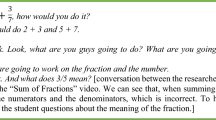Abstract
This study investigated whether a major new children’s television series on mathematics, produced primarily for an at-home audience, could be “repurposed” for classroom use. Segments were selected from the PBS children’s series, “Square One TV,” and edited into 30 videocassettes organized by curriculum topics. Teachers in two public elementary schools in Cambridge, Massachusetts, used the cassettes over a 10-week period. Both qualitative and quantitative data were collected, including teacher interviews, teacher journals of classroom use, researcher observations, a survey of student attitudes toward mathematics, and student interviews. Teachers found the reformatted cassettes to be useful motivational and instructional resources, especially in demonstrating connections between mathematical ideas and real-world situations. A videotape of teacher and student responses is available from the authors.
Similar content being viewed by others
References
Bloom, B. S., Engelhart, M. B., Furst, E. J., Hill, W.H., & Krathwohl, D. R. (1956).Taxonomy of educational objectives: The classification of educational goals. Handbook I: Cognitive domain. New York: Longmans Green.
Carlisle, R. (1987).Video: At work in American schools. Bloomington, IN: Agency for Instructional Technology.
Char, C., & Hawkins, J. (1987). Charting the course: Involving teachers in the formative research and design ofThe Voyage of the Mimi. In R. D. Pea & K. Sheingold (eds.),Mirrors of minds: Patterns of experience in educational computing. Norwood, NJ: Ablex.
Chen, M., Ellis, J., & Hoelscher, K. (1987).Repurposing children’s television for the classroom: Teachers’ use of Square One TV modular cassettes. Cambridge, MA: Harvard Graduate School of Education.
Chipman, S. F., & Wilson, D. M. (1985). Understanding mathematics course enrollment and mathematics achievement: A synthesis of the research. In S. F. Chipman, L. R. Brush, & D. M. Wilson (eds.),Women and mathematics: Balancing the equation. Hillsdale, NJ: Erlbaum.
Cuban, L. (1986).Teachers and machines: The classroom use of technology since 1920. New York: Teachers College Press.
Eccles (Parsons), J., Adler, T. F., Futterman, R., et al. (1985). Self-perceptions, task perceptions, socializing influences, and the decision to enroll in mathematics. In S. F. Chipman, L. R. Brush, & D. M. Wilson (eds.),Women and mathematics: Balancing the equation. Hillsdale, NJ: Erlbaum.
ETV Newsletter. (1987, November 9). Brief takes, p.4.
Fennema, E., & Sherman, J. (1976). Fennema-Sherman mathematics attitude scales.JSAS Catalog of Selected Documents in Psychology, 631.
Fennema, E., & Sherman, J. (1977). Sex-related differences in mathematics achievement, spatial visualization, and affective factors.American Educational Research Journal, 14, 51–71.
Fennema, E., & Sherman, J. (1978). Sex-related differences in mathematics achievement and related factors: A further study.Journal of Research in Mathematics Education, 9, 189–203.
Gage, N. L., & Berliner, D. C. (1984).Educational psychology (3rd ed.). Boston: Houghton Mifflin.
Gibbons, J. F., Kincheloe, W. R., & Down, K. S. (1977). Tutored videotape instruction.Science, 195, 1139–1146.
Martin, L. (1987). Teachers’ adoption of multimedia technologies for science and mathematics instruction. In R. D. Pea & K. Sheingold (eds.),Mirrors of minds: Patterns of experience in educational computing. Norwood, NJ: Ablex.
Mielke, K. (1977).Barriers to classroom use of The Electric Company: A formative analysis. New York: Children’s Television Workshop.
National Research Council (1985).Mathematics, science, and technology education. Washington, DC: National Academy Press.
National Science Foundation (1983).Educating Americans for the 21st century. Washington, DC: U.S. Government Printing Office.
Reed, S., & Sautter, R. C. (1986, November/December). Video education: Taking a new look at an old technology.Electronic Learning, 22–27.
Research Communications (1985).The CTW math series: Teacher study of five pilot programs. Chestnut Hill, MA: Research Communications Ltd.
Riccobono, J. (1985).School utilization study: Availability, use, and support of instructional media. Washington, DC: Corporation for Public Broadcasting.
Rowe, M. B. (1987, Spring). Wait time: Slowing down may be a way of speeding up.American Educator, 38–43.
Trachtenberg, D. (1974). Student tasks in text material: What cognitive skills do they tap?Peabody Journal of Education, 52–59.
Withrow, F. (1985). Videodiscs: The thinking person’s audiovisual.American Educator, 22–25, 41–42.
Author information
Authors and Affiliations
Additional information
This paper written while Dr. Chen was an assistant professor at the same school, won the Instructional Video Paper Competition marking the 25th anniversary of the Agency for Instructional Technology, Bloomington, Indiana.
Rights and permissions
About this article
Cite this article
Chen, M., Ellis, J. & Hoelscher, K. Repurposing children’s television for the classroom: teachers’ use of “square one tv” videocassettes. ECTJ 36, 161–178 (1988). https://doi.org/10.1007/BF02765465
Issue Date:
DOI: https://doi.org/10.1007/BF02765465




